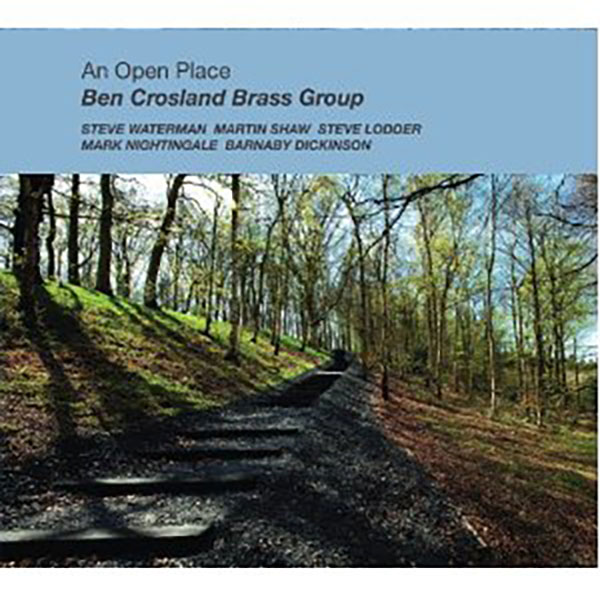
by Ian Mann
June 17, 2012
/ ALBUM
A well crafted album that features some superb ensemble playing alongside some excellent solo contributions from six very talented musicians.
Ben Crosland Brass Group
“An Open Place”
(Jazz Cat Records JCCD 114)
Seeing bassist and composer Ben Crosland perform recently at the 2012 Lichfield Real Ale, Jazz & Blues Festival with his trio Threeway steered me in the direction of his most recent album release. Crosland’s Brass Group is an extension of Threeway with the trio line up of Crosland, Steve Waterman (trumpet & flugelhorn) and Steve Lodder (piano & keyboards) augmented by three more horn players in the shape of Martin Shaw (trumpet & flugelhorn) plus trombonists Mark Nightingale and Barnaby Dickinson.
Based in Huddersfield, from where he runs his own Jazz Cat record label, Crosland is a proud Northerner whose albums often have a specifically Northern theme. The eight pieces here are inspired by sculptures at the Yorkshire Sculpture Park near Wakefield and came about as the result of a commission by the 2011 Marsden Jazz Festival. Vince Hepworth, warden of the Sculpture Park and a supporter of Wakefield Jazz Club suggested the theme, the album title coming from the fact that the YSP is set in rolling, open, parkland style countryside. The choice of instrumentation with its obvious links to the Northern brass band tradition represents another affirmation of Crosland’s roots.
The music builds on the values and virtues of the Threeway project. The Brass Group’s sound is similarly melodic and lyrical, pastoral even, but despite the lack of a drummer Crosland’s fretless electric bass provides an often surprising degree of tensile strength and rhythmic propulsion. He’s helped enormously by pianist Lodder whose use of electric keyboards also helps to add extra colour and texture.
Although some of the pieces are inspired by specific works of art the album opens with “An Open Place” itself, a kind of scene setter that attempts a musical description of the YSP as an entity. The piece quickly establishes a warm ensemble sound with Nightingale on trombone and Waterman on trumpet the featured soloists. Most importantly, like the rest of the album, it’s a fine team effort the horns providing rich colours and textures with Crosland and Lodder the harmonic and rhythmic glue that holds it all together. The pianist adds a dash of additional electronic colour to an already rich sonic palette.
The lengthy “Recline” is inspired by Henry Moore’s “Two Piece Reclining Figure” (cut1979-81) with Dickinson on trombone and Waterman, again on bright sounding trumpet, the featured soloists with Lodder occasionally leading from the piano.
“Pink Lady, Brown Dog” takes its inspiration from Sophie Ryder’s “Pink Lady Hare Dancing with Brown Dog” (2000).
Here the focus of musical attention shifts to the featured soloists Martin Shaw (trumpet) and Steve Lodder (electric piano). Shaw matches Waterman for fluency and Lodder’s use of the electric keyboard introduces a bold new primary colour.
The title of “The Prodigal” is an oblique reference to Barbara Hepworth’s 1970 work “The Family Of Man” with Lodder this time featuring on acoustic piano, opening up from lyrical beginnings to solo expansively. He is followed by leader Crosland on languidly liquid fretless electric bass. Crosland is an electric bass specialist, inspired not only by Jaco Pastorius but also by the late Jeff Clyne’s work with the fondly remembered Turning Point.
As the title might suggest “Running Man” injects an additional degree of urgency into the proceedings. The piece is inspired by Elisabeth Frink’s 1978 work of the same name, a photograph of which is reproduced on the album cover alongside some of the other works of art that inspired this project. Lodder and Crosland establish a suitably lively rhythmic base of interlocking grooves to act as the springboard for solos from Nightingale on fruity sounding trombone, Shaw on breezy trumpet and Dickinson, who vies with Nightingale for excellence on the other trombone.
Another Frink work, “In Memoriam II” (1981) also appears on the cover but as the title suggests the music is much more sombre in tone. Lodder establishes a reverent, almost funereal mood at the piano and later solos delicately and lyrically. Waterman’s sensitive and moving trumpet solo acts as a kind of valedictory.
“Black Steps” references David Nash’s 2010 work “Seventy One Steps” which is represented on the front of the album package. The music retains a lyrical, vaguely sombre, air with solos coming first from Crosland on lyrical electric bass and Shaw on velvety flugelhorn. Lodder’s piano provides a link to further solos by Nightingale and Waterman.
Finally comes “Walkin’ The Cat”, the title (presumably) referencing both Anthony Caro’s 1996 sculpture “Promenade” and Crosland’s own Jazz Cat record label. It’s one of the most upbeat items on the album underpinned by Lodder’s electric piano and Crosland’s slinky, suitably cat like bass line. Solos come from Dickinson on growling trombone, followed by Shaw whose contribution provides a bridge to a second trombone salvo from Nightingale.
“An Open Place” is a well crafted album that features some superb ensemble playing alongside some excellent solo contributions from six very talented musicians. Crosland’s writing is measured and intelligent and the project represents a logical but highly distinctive extension of the Threeway ethos. Some listeners may find it a little bloodless due to the lack of drums but the positives of this recording far outweigh any negatives. Crosland is a regional player with a national reputation and this is a worthy addition to the already impressive Jazz Cat catalogue. It may even inspire me to visit the Yorkshire Sculpture Park someday.